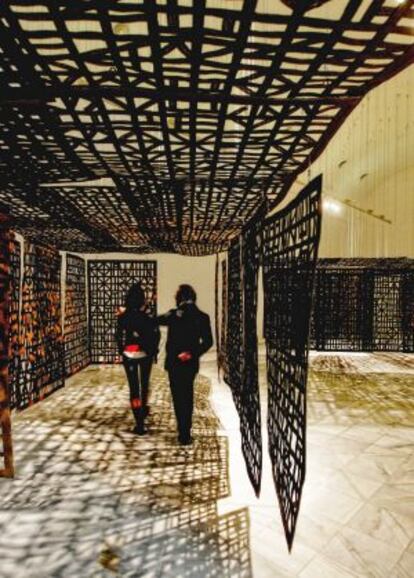Thinking water
Surveying Cristina Iglesias’ mold-breaking sculpture

Trellises featuring texts by French writers Joris-Karl Huysmans and Raymond Roussel; wells in which the flow of water creates sculptural sounds; walls of vegetation reminiscent of the Alhambra - these are just some of the works created over the three-decade career of San Sebastián-born sculptor Cristina Iglesias on show at the Reina Sofía museum's new retrospective of her work, Metonimia (Metonymy). Featuring 50 large-scale pieces, it's the most important survey to date of the career of the artist, who was awarded the National Art Prize in 1999 and is one of the most renowned Spanish names on the international art scene.
"Here is the heart of my obsessions," she explains, "open to be enriched by the eyes of the viewer."
An impressive nine-meter by six-meter piece entitled Techo suspendido inclinado (1997) hangs in the opening room from a first floor where the walls have been repositioned to give the light entering from the gardens the same prominence Iglesias gives it in all her work. It is followed by other pieces from private collections and the artist's own archive, as well as models of her major works in public spaces around the world. Two documentaries complete the display.
Curator Lynn Cook has taken Iglesias' last Spanish show, held in 1998 at the Palacio de Velázquez in the Retiro park, as the departure point for the new display, picking up where that exhibition left off with the public projects the artist has created in the United States, Norway, Germany, Madrid and, above all, Brazil. There are also lesser-known works and plans for uncompleted works, such as the one Iglesias is creating for Toledo's Year of El Greco in 2014.
Iglesias has reinvented sculpture, with a whole new artistic language"
Water is the most important element of the most beautiful and delicate works. The pozos (wells), her latest work, feature in the middle of the show, bathed in natural light. Here the repetitive sound of water returns, as in her celosías (trellises), to make the link with Arab culture. "There is something phallic, of ejaculation, of masculine essence about the water," says Reina Sofía director Manuel Borja-Villel. "Falling through these wells, it is transformed into a uterus, into something fragile and delicate, the essence of the feminine."
It's rumored that some of the exhibited pieces may enter the Reina Sofía's collection after the show finishes, but Borja-Villel says nothing has been decided yet. "Cristina Iglesias has reinvented sculpture," he says. "She is the creator who has contributed most to renewing an artistic language. She has learned, like no one else, how to break with the established concept of art. Her suspended sculptures, doing away with plinths, are full of mysterious stories revolving around plays with shadows and volume. The historical references, the rhythms and her way of weaving intimate dimensions into public spaces make her work reach unsuspected dimensions."
Cristina Iglesias: Metonimia . Until May 13 at Museo Nacional Centro de Arte Reina Sofía, C/ Santa Isabel 52, Madrid. www.museoreinasofia.es







































